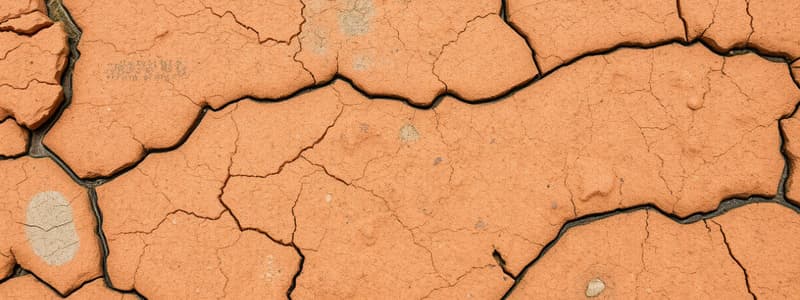Podcast
Questions and Answers
What is the primary cause of tsunamis?
What is the primary cause of tsunamis?
- Storm surges
- Underwater landslides
- Underwater earthquakes (correct)
- Volcanic eruptions
Which of the following processes describes the breaking down of rock into smaller pieces?
Which of the following processes describes the breaking down of rock into smaller pieces?
- Weathering (correct)
- Deposition
- Chemical alteration
- Erosion
What do scientists monitor to understand how earthquakes occur?
What do scientists monitor to understand how earthquakes occur?
- Volcanic activity
- Wind patterns
- Arrival of earthquake waves (correct)
- Sea level changes
In the context of geological processes, what is deposition?
In the context of geological processes, what is deposition?
Biogeography primarily focuses on which of the following aspects?
Biogeography primarily focuses on which of the following aspects?
What do phytogeography and zoogeography primarily study?
What do phytogeography and zoogeography primarily study?
Which event is likely responsible for the separation of the Old World and New World monkeys?
Which event is likely responsible for the separation of the Old World and New World monkeys?
How can scientists use the fossil record in biogeography?
How can scientists use the fossil record in biogeography?
What fundamental geographical factor greatly influenced early human civilizations?
What fundamental geographical factor greatly influenced early human civilizations?
What does the core-domain-sphere model in cultural geography illustrate?
What does the core-domain-sphere model in cultural geography illustrate?
What has been a significant driver of migration to Alberta, Canada since 2000?
What has been a significant driver of migration to Alberta, Canada since 2000?
Which region's economy is greatly influenced by its tropical climate and tourism?
Which region's economy is greatly influenced by its tropical climate and tourism?
How has the historical exploitation of natural resources affected modern Europe?
How has the historical exploitation of natural resources affected modern Europe?
What term describes Central America in relation to its economic dependence on a single crop?
What term describes Central America in relation to its economic dependence on a single crop?
Which natural resource has been crucial for the industrialization of Brazil and Argentina?
Which natural resource has been crucial for the industrialization of Brazil and Argentina?
What role do immigrants play in the economic growth of the United States?
What role do immigrants play in the economic growth of the United States?
What has shaped Canada's migration patterns alongside its economy?
What has shaped Canada's migration patterns alongside its economy?
Which aspect of Europe's economy has become more important than natural resources in recent times?
Which aspect of Europe's economy has become more important than natural resources in recent times?
What is Afghanistan's main natural export?
What is Afghanistan's main natural export?
Which country is noted for having the largest supply of rare earths?
Which country is noted for having the largest supply of rare earths?
Which of the following best describes the primary role of natural resources in South Asia?
Which of the following best describes the primary role of natural resources in South Asia?
What is Japan's most significant challenge regarding natural resources?
What is Japan's most significant challenge regarding natural resources?
Which Central Asian country is noted for its high levels of corruption affecting economic activity?
Which Central Asian country is noted for its high levels of corruption affecting economic activity?
What type of natural resource is Nepal primarily known for?
What type of natural resource is Nepal primarily known for?
Which country exports a significant amount of textiles and rice?
Which country exports a significant amount of textiles and rice?
Flashcards are hidden until you start studying
Study Notes
Earth's Surface Processes
- Earth's surface is shaped by various processes, including earthquakes, tsunamis, and volcanic activity.
- Earthquakes occur due to movements in the Earth's crust, creating faults and allowing scientists to model the Earth's interior.
- Tsunamis, often triggered by underwater earthquakes, can cause catastrophic flooding as they approach the shore.
- Volcanoes result from tectonic movements or mantle plumes, with eruptions providing insights into Earth's inner structure.
- Weathering, erosion, and deposition are key surface processes; weathering breaks down rocks, erosion transports fragments, and deposition occurs where materials settle.
Weathering, Erosion, and Deposition
- Weathering converts large rocks into smaller pieces through natural forces like wind and water.
- Erosion refers to the movement of these rock fragments by agents such as wind, water, and glaciers, with water erosion being the fastest.
- Continuous erosion alters landscapes over time, while deposition accumulates eroded materials in new areas.
- These processes are ongoing and crucial in landscape formation and modification.
Biogeography
- Biogeography examines the historical and current distribution of plants, animals, and other organisms.
- Phytogeography studies plant distribution, while zoogeography focuses on animals.
- Fossil records reveal the geographic distribution of ancient species and provide insights into evolution.
- The concept of Pangea illustrates how continental drift influenced species diversity, such as the separation of Old World and New World monkeys.
- Climate history helps understand organism adaptation and biogeographic regions identified by biodiversity.
Geography and Human Interaction
- Geography consists of physical geography, human geography, and geospatial techniques.
- Human geography focuses on population, culture, economy, and the interactions between people and environments.
- Cultural geography investigates how culture and environment influence each other, including globalization effects.
Cultural Geography
- Cultural geography looks at spatial relationships and how shared traits create culture regions.
- The core-domain-sphere model illustrates the concentration and diffusion of cultures.
- Geography significantly influences cultural conflicts, resource availability, and the development of civilizations.
United States Natural Resources
- The U.S. is rich in natural resources, including fertile soil, coal, and oil, which shape its economy and immigration patterns.
- The country has a vast coastline facilitating trade and a temperate climate ideal for agriculture.
- Historical events, like the Gold Rush, reflect the impact of resource discovery on population movement and economic growth.
Canada’s Resource Economy
- Canada's economy is driven by resource extraction, particularly oil and diamonds, with initial European settlements located near great waterways.
- The Alberta oil sands significantly influence economic development and migration within Canada.
Geographical Movement in Latin America
- Natural resources shape economic movement in the Caribbean, Central America, and South America.
- The Caribbean's tropical climate attracts tourism, while Central America serves as a land bridge with limited resources, leading to economic dependence.
- South America benefits from abundant resources, which drive industrialization and attract foreign workers.
Natural Resources in Europe
- Europe's mild climate supports agriculture, yet modern economies rely more on services than natural resources.
- Historically, natural resource exploitation fueled economic growth during the Industrial Revolution.
- Current trends show resource-based business shifts, with companies moving operations abroad for cheaper extraction.
Natural Resources in South Asia
- South Asia has multiple natural resources, including minerals, fertile lands, and energy sources like coal and oil.
- India and Bangladesh rely on agriculture due to their fertile lands, while Pakistan capitalizes on natural gas and agriculture.
- Tourism substantially contributes to economies in Maldives and Sri Lanka, attracting millions each year.
East Asia Natural Resources
- East Asia comprises countries with varying resource availability; China has abundant resources, while Japan has to import most of its needs.
- North Korea holds significant resources, yet sanctions limit its market opportunities, affecting movement.
Central Asia and Russia Resources
- Central Asia is abundant in natural resources, critical for economic development, particularly in Russia and Kazakhstan.
- Poor governance and corruption hinder the effective exploitation of resources, impacting economic mobility and migration patterns within the region.
Importance of Natural Resources
- Natural resources drive modern economies, influencing human movement, capital flow, and population dynamics worldwide.### Natural Resources and Economy
- Australia is rich in natural resources, with record exports in 2014 driven by coal, iron ore, and gold.
- Metals account for 28% of Australian exports, with coal contributing 18%; 60% of coal mined is exported.
- New Zealand's major exports include dairy products, timber, oil, and beverages, with agriculture playing a significant role.
- Pacific Islands primarily engage in subsistence farming, limiting export potential but boosting tourism due to scenic beauty.
Human Movement and Settlement Patterns
- Natural resources influence human behavior, facilitating the movement of people and capital.
- Australia and New Zealand attract migrants seeking opportunities in resource-based industries, boosting local economies.
- Cultural practices in the Pacific Islands promote movement between islands for familial ties, despite economic limitations.
Geography of North America
- North America consists of diverse regions: Mountainous West, Great Plains, Canadian Shield, Eastern Region, and Caribbean Region.
- The Mountainous West features the Cordilleras, including the Rocky Mountains and Sierra Madres, home to varied populations.
- The Great Plains, often called North America's "breadbasket," is fertile and central to agricultural production.
- The Canadian Shield is a plateau known for logging due to its cold climate and rocky terrain.
Physical vs Human Characteristics
- Physical characteristics refer to landforms like mountains, rivers, and lakes, contrasted with human characteristics such as cities and roads.
- Major U.S. cities tend to be near water sources, crucial for transportation, agriculture, and drinking water.
- Key U.S. landforms include the Rocky Mountains, Grand Canyon, and the Great Lakes, with significant rivers like the Mississippi.
U.S. Statehood and Geography
- A state is a governing entity controlling territory; examples include the 50 United States and territories like Puerto Rico.
- Characteristics to identify U.S. states include size, shape, panhandles, unique location, and regional commonalities.
Historical Context of U.S. Expansion
- Early settlement in the U.S. began with the establishment of 13 colonies and expanded westward due to natural resources and government land purchases.
- Immigration significantly contributed to population growth and economic productivity, facilitating expansion.
- Transportation advancements, such as railroads, telegraphs, and highways, greatly accelerated westward migration and connection.
Canadian Geography and Economy
- Canada is the second-largest country globally, featuring vast landforms including the Canadian Cordillera and Shield.
- The Canadian Shield consists of extensive forest land and numerous lakes, while the Arctic region holds potential for future economic development.
- The Alberta oil patch is a crucial component of Canada's economy, highlighting the significance of natural resources in shaping the country's growth.
Studying That Suits You
Use AI to generate personalized quizzes and flashcards to suit your learning preferences.




